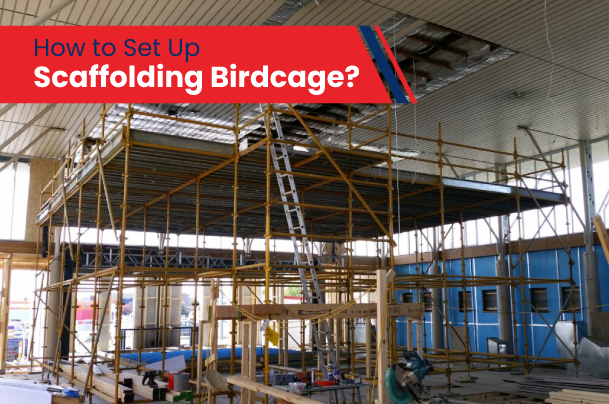
As skyscrapers pierce the sky, safety and efficiency during construction projects are paramount. Birdcage scaffolding construction guarantees both safety and efficiency in thousands of construction projects.
This type of scaffolding provides such a secure platform that workers can operate at any height with full efficiency. In this article, we will explain in detail how to correctly set up a birdcage scaffolding system.
What is a Birdcage Scaffolding?
Before we break down the process of installing birdcage scaffolding, it is essential to understand what birdcage scaffolding is. The scaffold system is not a new concept to humanity. In fact, this system existed 17,000 years ago for creating ancient paintings on high ceilings, even in ancient Greece.
Of course, today the birdcage scaffolding system has advanced significantly in terms of applied technology. Known for its resemblance to a birdcage structure, it consists of multiple vertical and horizontal poles. Birdcage scaffolding is a structure similar to a birdcage and is ideal for large projects where workers need flexibility and safety in wide and high areas.
How to Build a Birdcage Scaffolding Step by Step
Step 1: Planning and Preparation
The formulation of a detailed plan is the basis for a safe scaffolding setup. Start by assessing the workplace and determine the height and area that will cover it. Make sure you have the right permission to start construction and that the ground is stable and level. Secure all the necessary material:
- Base plates and sole boards
- Standards (vertical poles)
- Ledgers (horizontal poles)
- Transoms (horizontal supports)
- Braces (diagonal supports)
- Scaffold planks
- Couplers and fittings
Step 2: Installing the Base Plates and Sole Boards
- To even out the scaffolding’s weight distribution, set the foundation plates on solid ground.
- To avoid sinking and provide a level base, place sole boards beneath each base plate in cases where the ground is soft or uneven.
Step 3: Erecting the Standards
- Establish the corners of your scaffolding by positioning the standards, which are poles that are upright, on the foundation plates at regular intervals.
- Make sure the standards stay straight and sturdy by securing them with base collars.
- To keep the structure from collapsing, the spacing between the standards should always remain the same.
Step 4: Attaching the Ledgers and Transoms
- After that, use right-angle couplers to fasten the ledgers (the horizontal poles) to the standards. For the scaffold’s planks, the ledgers will run horizontally down its length.
- Install the transoms, which are extra horizontal supports, at regular intervals between the ledgers once the ledgers are in place to form a grid-like design. As a whole, the scaffolding is more stable with this arrangement.
Step 5: Securing the Braces
- In order to keep the birdcage scaffolding stiff and stable, braces are an absolute must.
- Using swivel couplers, attach diagonal braces at regular intervals, making sure the construction stays square and aligned. The scaffolding is kept from wobbling and given extra strength by the correct bracing.
Step 6: Laying the Scaffold Planks
- After the structure is fastened, lay the boards of the scaffolding over the transoms to provide a platform for working.
- Make sure the boards are level and well secured so that the surface is safe for workers.
- Verify that the planks are sound and capable of bearing the weight you want to use them for.
Step 7: Installing Guardrails and Toeboards
- No construction project is complete without prioritizing safety.
- To avoid falls, set up rails around the edge of the platform where you’ll be working.
- To further secure the platform and keep tools and materials from sliding off, fasten toeboards to its edge.
Step 8: Conducting a Safety Inspection
- Perform a comprehensive safety check of the whole birdcage scaffolding system before work begins.
- Make sure the scaffolding is steady, check for any loose fittings, and make sure all components are connected securely.
- In order to keep the project safe, inspections should be done often.
A Few Closing Words
Today, the construction sector is experiencing a real boom. Often, the need to complete projects as quickly as possible leads to the neglect of many aspects of the construction process, consequently putting the lives of workers at risk. For this reason, an ideal and fully guaranteed solution is the installation of birdcage scaffolding construction.
Scaffolds Supply provides a wide array of birdcage scaffolding components, designed to ensure safety and stability in construction projects. Our inventory includes vertical standards, horizontal ledgers, transoms, base plates, and braces, all crafted from high-quality materials for durability and reliability. These components are crucial for building a secure birdcage scaffold structure, offering essential support for workers and equipment at various heights. Whether the project requires a small or large birdcage scaffold, Scaffolds Supply has the appropriate components to meet those needs.











Comments are closed